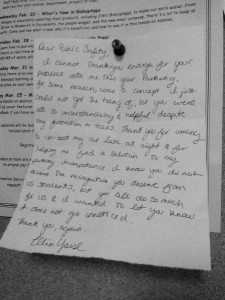By Anonymous
Transcript Contributor
Counseling wasn’t something I ever thought I would ever need.
Blessed with a healthy mind and a privileged life, I had no need to see a psychologist or psychiatrist, or even visit my school guidance counselor. I was content with my life and everyone and everything in it. My brother had an anxiety disorder for as long as I could remember, but he and my parents managed it well.
When I was 16, my parents told my brothers and me my dad was struggling with depression, but he was dealing with it in a healthy way and making a lot of progress. Mental health didn’t seem like a threat, but then it was. In a few short months my dad unraveled. He lost his battle with depression just before my seventeenth birthday.
When it happened, I felt like my life was in pieces. But seeing a counselor every week helped me put the pieces of my life together again. It was the reason I was able to sort through my thoughts and process what had happened.
It gave me the determination to get out of bed and go to school. It brought my family back together again, and we are now stronger than ever. I came to Ohio Wesleyan because this was the only college I felt could truly support me.
When I came in for my interview as a high school senior, I was comforted and supported by a woman who was supposed to be questioning me, not telling me that I would be happy here, at home here.
I was told this is a community filled with love and unity, and I could tell it was. My visit to OWU reassured me that this is a school that nurtures and helps its students grow.
I’ve been here for two years now, and although I am growing, I’m also still grieving. I still am not perfect, I still need help, and I know I’m not alone.
When I first tried to make an appointment with counseling services, I was frustrated because they told me they couldn’t take me for two months. I decided I couldn’t wait and would go home to see my therapist when necessary.
But not everyone is as lucky. Not everyone can leave to see their doctor whenever they want, and not everyone has the money to afford professional help. When students can’t get an appointment right away, many of them find themselves not getting it. And that has to stop.
Everyone should be encouraged to take care of their mental health, and have the opportunity to receive individual attention.
The death of a loved one, trouble at home, sexual assault, addiction, a mental disorder or anything that overwhelms and paralyzes a student from being their best self is a problem. We need to start recognizing that the brain is an organ and it can fail us. When our body is sick, we have the resources on hand to help it heal. Why don’t we have the same for our mental health?
The counselors here are simply remarkable, which is why it is such a shame that they do not have the staff to cater to the demands of our student body. A mental health problem doesn’t wait for a time of your convenience, so a waitlist for counseling shouldn’t be happening either. If students are hurting, they should be encouraged to reach out, and they should be welcomed with open arms.
The initiative for more funding for Counseling Services needs to be supported. You might not realize the necessity of counseling, but do you really want to wait until you do? Don’t you deserve to have this incredible resource available to you when you need it?
If you haven’t already, sign the petition sponsored by the House of Peace and Justice to prioritize Counseling Services. Contact your WCSA representative, email an administrator, or both. We need to demand that an increase in funding for Counseling Services becomes a priority.
Ours is a school that takes pride in its strong, loving sense of community, and we need to actively work to keep it that way. Let’s keep OWU students happy and healthy. Let’s get everyone access to Counseling Services.












